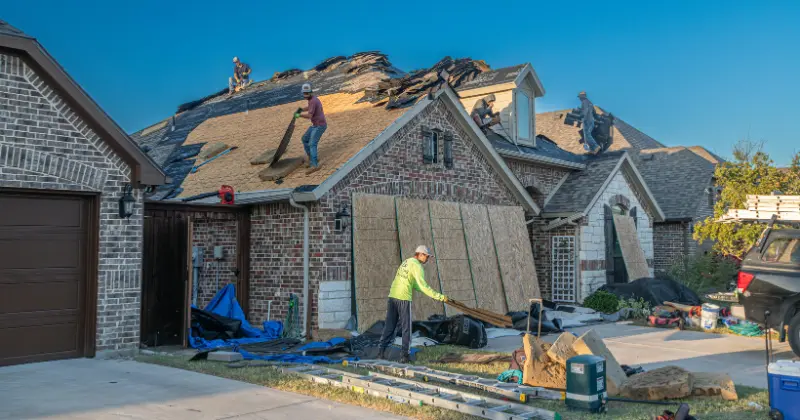11 mins read
Everything You Need to Know to Take Your Quantity Takeoff to the Next Level

- What is a Quantity Takeoff in Construction?
- Why are Quantity Takeoffs Important
- Top Quantity Takeoff Methods
- Other Quantity Takeoff Methods: Building Information Modeling (BIM)
- Common Quantity Takeoff Challenges & Mistakes
- How To Do a Quantity Takeoff: Tips & Best Practices
- Top 5 Features of Quantity Takeoff Software
- Conclusion
Regardless of the nature of a project, the best-laid plans are only as good as the measurements used to make them. This is where creating an accurate quantity takeoff (QTO) comes into play. As an integral part of the cost estimation process, QTOs enable estimators to simplify a large project by splitting it into smaller, more manageable sections in greater detail.
But what is the fundamental importance of this process in the modern construction landscape, and how can you leverage technology to make it more efficient? Keep reading to learn the definition of quantity takeoff in construction, its importance, common methods, best practices, and more!
What is a Quantity Takeoff in Construction?
A quantity takeoff, also known as a construction takeoff, is the process of analyzing drawings and plans to list and measure the materials and labor needed to complete a project. Companies use QTOs to estimate costs and define accurate project budgets.
The QTO is generated during preconstruction planning at the earliest stages of a project. The process involves breaking down the project into smaller sections that are easier to measure and estimate, and generating a detailed document to assist stakeholders in forecasting costs.
To do so, the estimator references drawings, blueprints, and 3D models to get the exact information and make the takeoff as accurate as possible. For example, if you are building a concrete foundation, the QTO would list the physical materials needed, such as concrete, and the time and labor required to complete the build. The estimator will then use that information to better understand the project’s scope, build a timeframe, designate duties, and create an accurate cost estimate for each item.
Despite the importance of the process, there is still not enough clarity around the true definition of QTO. Many believe it is just about quantifying materials. However, the process is about measuring a project’s work through small work items, including labor and materials. Confusion mainly arises because of the many synonyms that exist to describe this process, such as estimating takeoffs and material takeoffs.
Quantity Takeoff vs. Material Takeoff
While the two concepts are used interchangeably on most occasions, they don’t mean the same, and understanding the differences is of utmost importance to ensure there are no misunderstandings during the completion of these processes.
On one side, quantity take off measurements are made “net in place,” which means they use the exact information from drawings to estimate items. In contrast, material takeoffs (MTO) are measured in gross quantities.
On the other hand, the most significant difference between the two is that construction takeoffs are not always related to materials but to project work. Some measured items only involve labor-associated costs, such as hand troweling, which are measured using other methods. MTOs, on the other hand, only measure quantities of physical materials.
How Do QTOs and BOQs Relate?
A quantity takeoff and a Bill of Quantities (BoQ) are closely related but serve different roles during the preconstruction, procurement, and construction stages.
On the one hand, a QTO lists quantities of materials, labor, and, on some occasions, equipment with information directly extracted from drawings and other documentation. On the other hand, a BoQ is a formal contractual document generated after the QTO. It organizes quantities into work items with a description of the work, unit of measurement, quantity, unit rate, and cost.
Therefore, an effective QTO is fundamental for a reliable BoQ. Both documents support effective cost estimation, bidding, procurement, and cost control across the project.
Who is Responsible for QTOs?
The process of taking off quantities is required in any kind of project, regardless of the industry; for example, a baker needs to list and estimate the costs of ingredients they will need to buy to bake a cake. In construction, depending on the project’s size and scope, many people will be responsible for the process. Generally, the project owner hires a construction estimator or a quantity surveyor to accurately take off with the help of architects, engineers, and the project manager (PM).
Contractors and subcontractors must also conduct a takeoff to price their work during bidding. Communication between all parties is paramount to ensure maximum efficiency and accessibility.
Why are Quantity Takeoffs Important
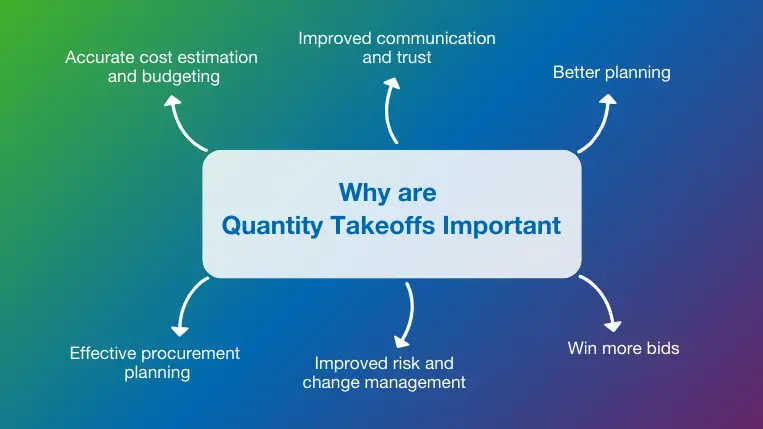
As mentioned earlier, in its simplest form, a QTO determines precisely how much material and labor are needed to complete each project work, which is recorded in the bill of quantities. In reality, takeoffs can be complex, with many different areas and people involved.
No matter the scale of the project, an accurate QTO is critical for success. Without accurate takeoffs, multiple areas of budgeting and planning can fall short. But what are the tangible benefits that make this process so important today? Let’s explore them below.
Accurate cost estimation and budgeting
We already mentioned this point a few paragraphs ago, but it is arguably the most significant benefit of this process. A well-thought-out quantity takeoff provides the foundation for accurate cost estimation and budgeting. By understanding exactly what work needs to be done and how much material and labor are required, estimators can forecast costs and define a budget based on accurate information from project documentation. This will help avoid budget overruns in the future, as you can leave enough room for unexpected expenses.
That said, the QTO alone will not provide the necessary information to estimate costs completely. Cost estimation in construction involves many steps that start with takeoff. However, without the specifics provided in the QTO, the estimation process can be inaccurate and negatively affect the project later.
Improved communication and trust
If there is any common goal between all building projects, no matter how big or small, it is money and how smartly you can spend it to complete the project with the most significant return on investment. The only way to do this is through efficient planning and communication. A QTO provides the necessary overview to keep every stakeholder informed about the components and costs related to the project. In this way, transparency is ensured, and the ever-present issue of construction communication is resolved.
Better planning
Aside from the cost-estimating benefits mentioned above, the information provided by a construction quantity takeoff also enables accurate planning and scheduling of the different project works. This helps teams optimize their workflows and avoid downtime to ensure everything is completed within the expected timeline, significantly enhancing productivity in construction projects.
Win more bids
In the construction industry’s competitive landscape, accurate quantity takeoff can provide a competitive advantage over other contractors. The more professional and accurate the takeoff, the more efficient and professional the contractor is, which can lead to winning more bids. Taking off quantities can be tedious but examining them thoroughly can be the winning formula during bidding.
Improved risk and change management
QTOs force a detailed review of relevant documentation, including drawings and specifications. This allows for the early identification of inconsistencies or missing information, which reduces the risk of errors later. An accurate quantity takeoff also serves as a baseline to evaluate the impact of different design changes or variations on the budget. It also minimizes the chances of underestimating the scope of work, a common cause for budget overruns, making them perfect tools for effective construction risk management.
Effective procurement planning
Accurate and detailed quantity takeoffs are highly linked to effective procurement management in construction. These powerful documents help the procurement team order the exact quantities of materials needed to avoid overspending more than required. They also support value engineering by allowing the team to compare different material alternatives to balance cost and quality. Lastly, they provide precise quantity data that allows for better vendor negotiations and avoids potential supply chain disruptions.
Top Quantity Takeoff Methods
A quantity take off is an essential part of the pre-construction phase. Any errors made here can significantly impact the rest of the project, including cost estimation, overall budget, timeline, and daily workflow. Doing it right is necessary for a smooth operation.
Owners, contractors, and subcontractors must successfully perform a quantity takeoff to move forward with their jobs. There are two different methods: manual and digital. We will explore them in detail below.
1. Manual Quantity Takeoff
This is the traditional, older way of quantity take-off without software (aside from a little Excel). With this method, estimators reference the plans to measure and list all the required physical materials and labor. Then, they look at the plans and use various formulas and calculations to determine the exact quantity of each item. This information is then used to produce cost estimations later.
While a manual QTO may seem straightforward at face value, these operations can be incredibly complex. There are many different equations, as well as many materials and small details to consider. Any errors here can result in either an overestimation or an underestimation, significantly impacting the project and budget.
The pros of this method are mainly the reliance on the experience of the professional carrying it out. The method is also less expensive and more dependable than technology in particular scenarios. Plus, it can be an effective way to double-check whether what the digital method showed is correct.
A longer list of “cons” is attached to this method. Doing a manual QTO opens the door to human error. No matter how skilled or experienced the estimator may be, there is always the possibility of inputting a wrong figure or making an incorrect judgment. Even the most minor incorrect details can have significant consequences later in the project. Plus, the process is quite slow as everything needs to be done manually. Considering how fast projects move and change today, taking the time to do this manually might not be a privilege teams can afford.
2. Digital Quantity Takeoff
Of the two methods of taking off quantities, a digital QTO is usually the preferred option because it is supported by the latest technology to make the process fast, accurate, and efficient. Construction software with digital takeoff features streamlines the process with automated formulas and equations that vastly decrease the risk of human error and the time it takes to get the expected results.
With a digital QTO, you simply scan the blueprint into the software to analyze it and create a precise list of all materials required for the project. Then, you can assign automated, error-free formulas to the materials and run them through the software to get accurate construction takeoffs. If something is incorrect or strange, the estimator can always make manual changes wherever necessary.
Using a digital platform like this also means that you can use and reference your past QTOs for your current and future projects. Cloud-based systems store everything in one place, allowing all team members and stakeholders to access it anytime and from any device, keeping data safer while improving collaboration.
The pros of this method are pretty straightforward. Digital construction reduces the risk of error, minimizes wastage, and increases efficiency. Plus, it is significantly faster than manual methods, thanks to automation, and way more collaborative, thanks to the accessibility provided by the cloud.
There are few cons, but a downside of this method is the need to scan massive drawings that must be made accessible to everyone. If not calculated correctly, this can affect the accuracy of the takeoff.
Other Quantity Takeoff Methods: Building Information Modeling (BIM)
Considered a subset of the digital QTO method, BIM delivers the most accurate and efficient technology for digital 3D takeoff. The technology offers a digital 3D model of the building or structure with centralized data from all disciplines, providing a virtual model to simulate the project and extract valuable information related to quantities and costs.
During the QTO process, BIM software, such as RIB CostX, can help automate the extraction of quantities directly from the model, eliminating the need for manual calculations and human error. Plus, the level of accuracy is significantly increased because the latest changes to the design and specifications are already reflected in the 3D model, and the different team members can access the information whenever needed.
Additionally, BIM technology enhances the cost estimation process by allowing users to experiment with material variations within the model. Even with this additional step, the entire takeoff and estimation process can be done in a fraction of the time, regardless of the project’s complexity.
If you want to learn more about the value of this technology, check out our guide on the history of BIM.
Common Quantity Takeoff Challenges & Mistakes
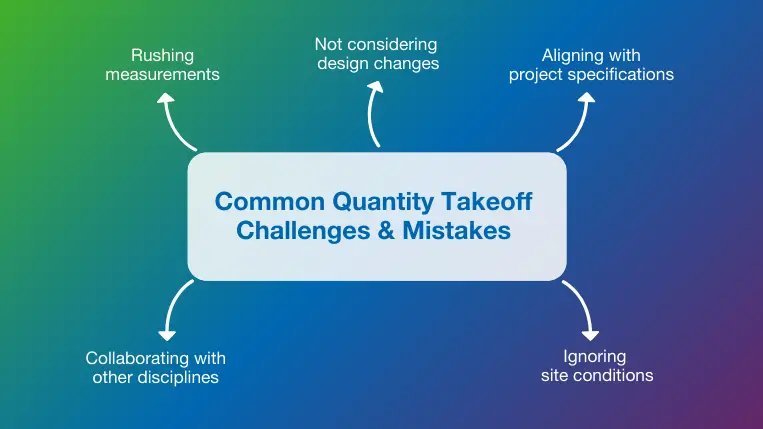
As straightforward as it sounds, taking off quantities can be complex. Awareness of common mistakes or challenges can help avoid them and achieve success.
Rushing measurements
Errors in scaling, incorrect dimensions, or outdated drawings result from rushing through measurements. Accurate measurements are fundamental, as inaccurate data can lead to a cascade of issues during construction, including material delays or insufficient quantities. These issues can result in costly rework, schedule delays, and budget overruns that affect project success. To avoid these potential challenges, estimators or quantity surveyors should support themselves with tools and technologies to ensure precision, always double-check, and not rush the measurement process.
Not considering design changes
Construction projects continuously evolve as new requirements and variables appear. This challenges professionals, as documents and plans must be updated every time something changes. If QTOs don’t reflect those changes, it can lead to issues like material shortages or budget overruns. Luckily, tools have been developed to eliminate the need to manually update quantities every time a design change occurs. For example, RIB CostX live-links drawings and estimates, ensuring that quantities are automatically updated every time a design change occurs, mitigating the risk of errors and leaving time to focus on other high-value tasks.
Aligning with project specifications
As mentioned, QTOs are generated by analyzing information from drawings and other documentation. One such document is the construction specifications, which contain detailed information about the project scope and specific quality requirements that can effectively inform the QTO. That said, many teams face the issue of rushing through the process and not considering specs, which can become a big issue as details like specific material requirements can be ignored and lead to costly rework. Collaborating with the design team during the quantity takeoff process is fundamental to avoid these kinds of issues, ensuring everyone can bring their knowledge and expertise to the project to be successful.
Ignoring site conditions
This challenge or mistake is tied to the two previously discussed. When performing a QTO, referencing drawings is insufficient to consider the job complete. Together with drawings and specs, the conditions of the construction site should also be accounted for. For example, when visiting the site, you might realize that uneven land or poor soil conditions require additional resources. This is fundamental not only to calculate quantities and costs accurately but also to ensure the safety of the workers.
Collaborating with other disciplines
It is no secret that collaboration in construction projects has been a challenge for the industry for a long time and is still a challenge today. The situation is no different with QTOs, as the process often involves multiple trades and design disciplines that must coordinate to avoid duplicated or missed quantities. Regular coordination meetings and drawing reviews between estimators, engineers, and architects can help prevent scope overlaps or omissions affecting QTO accuracy. Likewise, investing in professional construction collaboration software to implement a single source of truth for all processes and information is another best practice for success.
How To Do a Quantity Takeoff: Tips & Best Practices
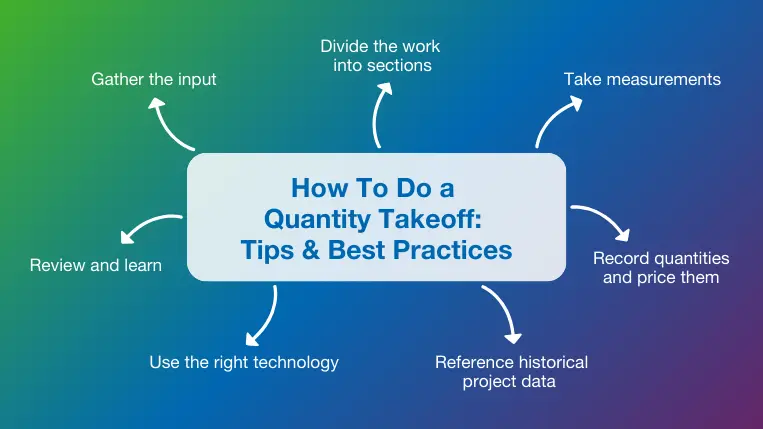
As we have explained, a construction quantity takeoff involves reviewing project design documents to extract quantities of materials and labor to estimate costs and define a budget later on. With the right solutions, building professionals can generate accurate QTOs quickly and efficiently. However, the process involves many stages, and even the best software can’t help if key considerations are not accounted for.
Below, we’ll discuss some essential best practices to ensure success.
Gather the input
The first step is to understand the project. Thoroughly review all documents, including specifications, architectural drawings, engineering plans, and contracts, to understand the scope and objectives.
The person in charge of the takeoff is not necessarily responsible for the project’s design specifications. Although they should trust the documents above, this step also involves feeding the data extracted from these documents into your takeoff software and reviewing its accuracy and validity. Here, the takeoff professional should also use their expertise to identify and report errors or discrepancies to the management team.
Divide the work into sections
This best practice is especially useful in complex projects involving many items. A good strategy is to divide the project into smaller, more manageable parts and tackle one individually. For example, some high-rise projects are divided by floors; others might be divided by phases or, in large ones, by buildings.
But it does not stop there. After the categorization, the sections are divided into smaller sections called “assemblies,” which are work components. For example, when dealing with a perimeter wall, the estimator will need to takeoff multiple elements that go into assembling the wall, such as concrete, reinforcing steel, rubbed finish, etc.
Take measurements
Once the scope and input are defined, the estimator (or whoever is responsible for the QTO) should use the data extracted from the documents to measure the different items. Various methods or techniques can be used depending on the nature of the item being measured. For example, you will quantify drywall differently than doorknobs or nails.
- Unit count: As its name suggests, this technique quantifies items in units, such as doors, windows, sinks, etc. Sometimes, an item’s unit might consist of more than an individual object, such as nails, where one unit is actually five hundred nails. Quantifying items based on units is a great help during estimation, as you only need to multiply the items by their unit price.
- Linear length: This measurement technique is used for items that need to be quantified according to their length, such as electrical wiring or pipes.
- Surface area: The following technique for taking off quantities is to calculate the amount of material needed to cover an area. For example, you can calculate the length and width of a space to see how much carpet or flooring you need to purchase.
- Weight: This technique measures items by their weight, such as a ton of sand. Overestimation is usually necessary to ensure the correct amount is purchased. This also helps determine transportation costs.
- Cubic volume: This technique is used for three-dimensional materials that are needed to fill a space, such as concrete or earthworks. To calculate it, estimators use the following formula: length x width x height.
Record quantities and price them
After completing the materials and labor list, it is time to record the quantities and give them a dollar amount. Here, it is essential to find a balance between price and quality and ensure no errors are made that could derail the budget later. This is the stage where the project is brought to life with more tangible information. The goal is to align the takeoff data with a pricing system.
Reference historical project data
Using historical data from previous projects is invaluable for precise quantity takeoffs and cost estimates. By analyzing this historical data, estimators can benchmark current projects against past ones, identify trends, and make informed adjustments for factors like inflation or market fluctuations. This process involves regularly updating the data to ensure it remains relevant and accurate. Over time, this historical database becomes an indispensable tool for continuous improvement in project estimation and execution.
Use the right technology
To produce a construction quantity takeoff, estimators mostly use Excel estimating software, which has long been ubiquitous for construction estimation with its user-friendly features; however, it has limitations. For instance, updating templates can be laborious, often requiring file-by-file adjustments, and sharing information can be cumbersome. Due to design changes or additional requirements, quantity takeoffs are frequently adjusted during estimation, especially when it comes to large or complex projects, and even after a bid is secured, changes can still occur. In addition, it can be challenging to achieve standardization as the project grows in size and complexity.
Some firms use independent tools tailored for QTO and estimation. The result, however, is that data needs to be shuffled from one user to another. Even if there are connectors, in many instances, data is moved from system to system manually. The result? Inaccuracies that, at times, can derail a project and cause significant cost overruns.
Considering all that, using cloud construction software can significantly enhance the process. These solutions are accessible from anywhere, providing optimum control over shared information. The information contained on a cloud-based platform is always current and detailed. The data is available immediately, facilitating smoother cross-department communication, expediting report sending, and enhancing standardization. For instance, by using BIM-generated visuals and data, teams can more efficiently create the most accurate takeoffs and specifications and more effectively deal with any changes via early simulations before making physical changes on-site.
Review and learn
One of the most valuable tips is continually reviewing and learning from the process. Collect feedback from the team and find ways to improve it, not only for the current project but also for future ones. This best practice helps pinpoint systematic errors, understand the reasons behind any variances, and refine your estimation techniques. Establishing a quality control system for your quantity takeoffs from the early stages of the project is a great way to improve the accuracy of the results.
Top 5 Features of Quantity Takeoff Software
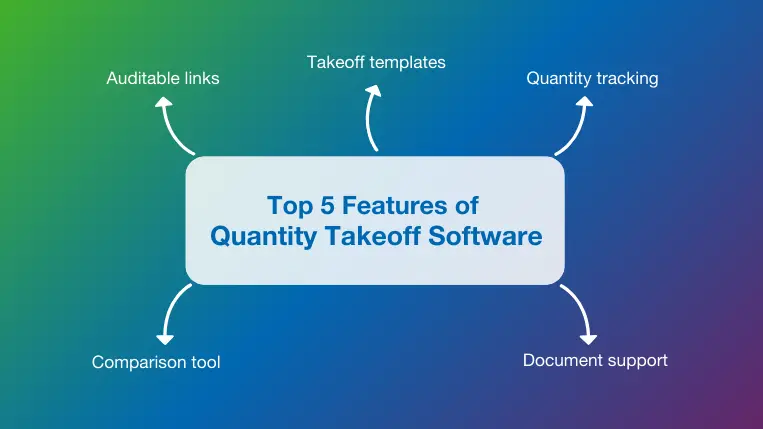
Choosing an estimation software solution with the right features, such as RIB Candy, is invaluable. Beginning with data collected from design blueprints and notes, an accurate QTO becomes a living document constantly updated to reflect a project’s changing situation and the client’s needs. Estimation software allows estimators to create up-to-the-minute measurements of the materials and labor required to complete a construction project, allowing better risk management, increased productivity, and the creation of attractive tenders.
To help you decide on the best solution, here are five features crucial to creating better QTOs:
1. Auditable links
Information sharing is central to ensuring everyone on a project is working from the same data pool. With a fully auditable link from Candy to your Bill of Quantities (BOQ), users can transfer measured quantities from the QTO to create or update a BOQ for pricing or progress claims.
2. Takeoff templates
The most efficient way to maintain accurate measurements on project work is to use templates to standardize and streamline your processes. This is especially useful for quantities that require routine updating. Templates can be created to track all these items in real-time and are fully customizable to include variables, formulas, and BOQ items.
3. Quantity tracking
Quantities can be separated into the various stages of the contract by splitting their measured amounts into Bill, Final, Claimed, and Actual Quantities. By comparing these amounts at the end of the project lifecycle, you’ll better understand the difference between projected versus actual costing and can better plan for future tenders, increasing the likelihood of winning them.
4. Document support
Waiting for documents to be ready or accessible is a huge waste of time. For that reason, the software you decide to invest in must allow for speedy access to drawings and blueprints with minimal memory usage, regardless of the user’s computer hardware. This, paired with a user-friendly interface, allows the QTO’s PDF Viewer to facilitate accurate measurements.
5. Comparison tool
Seeing is believing, which is why having an image comparison tool is so important. By allowing two drawings to be overlaid for easy comparison, changes can be identified immediately and are easier to track. While plans will change across a project’s lifecycle, your ability to track information in real-time is only as good as your software solution and its features. As an estimator, having the best tools available improves your ability to generate the most accurate takeoff and, in so doing, the best possible estimation for your projects.
Conclusion
As this post has indicated, QTO is a fundamental process for correctly estimating costs in your construction project. There are two different quantity takeoff methods for creating estimates. However, digital processes are quickly taking over and are much more popular these days, thanks to their added benefits, such as reducing errors and wastage and increasing accuracy and efficiency.
If you are ready to embrace the power of state-of-the-art construction estimating software, such as RIB Candy, that provides an on-screen take-off solution, and achieve tremendous success in your projects, book a demo today!
Get My Free RIB Candy Demo Now
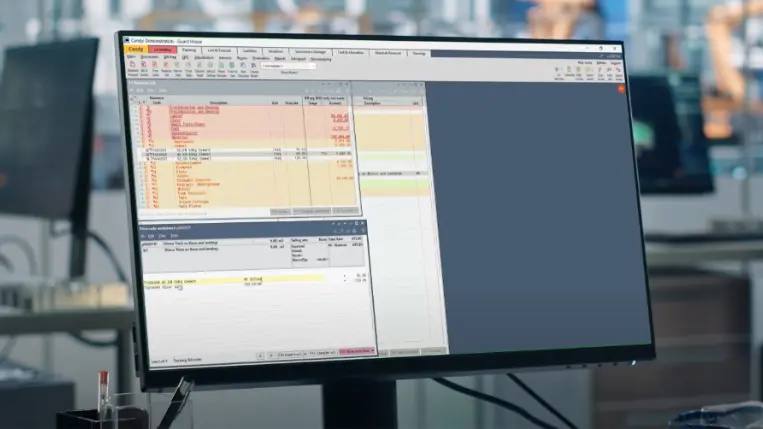
Most Recent
11 mins read
10 mins read
10 mins read
29 mins read
Blog Categories
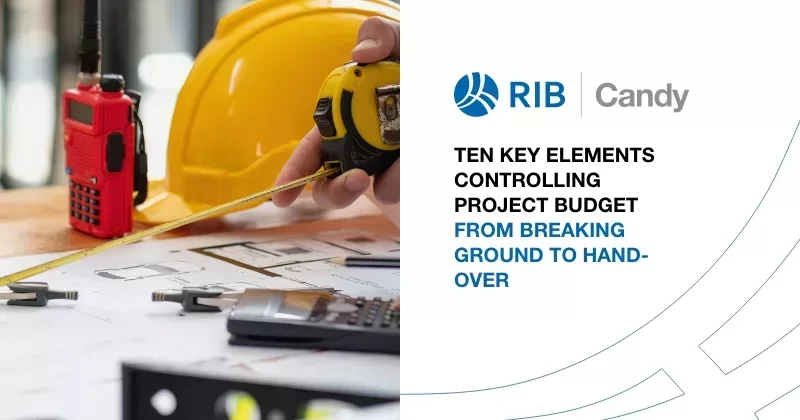
Ebook




